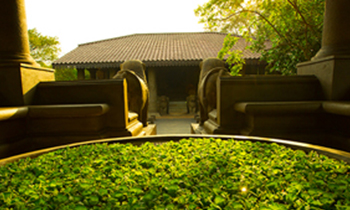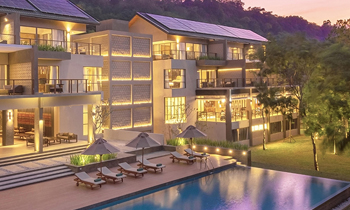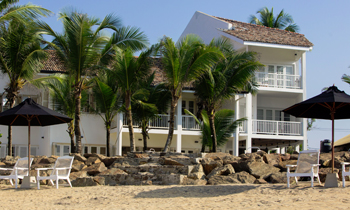Jewelry, masks, lacquer work, lace weaving, pottery, handlooms and more… Discover the varied arts and crafts unique to Sri Lanka. You can see the work that goes into creating them as you travel around the country and watch deft hands weaving intricate lace patterns or creating pottery over wheels in action.
This itinerary has been carefully designed to give you a taste of the exciting, endless possibilities and can be tailored to suit your exact preferences.
Drive time: 45 minutes
Overnight: Villa Hundira – Breakfast included
On arrival at the Bandaranaike International Airport, you will be warmly greeted by your chauffeur guide and transferred to your villa in Negombo.
Upon arriving, check into your villa and visit the arts and craft workshop next door and see how over 300 village ladies have empowered themselves by displaying their craftsmanship and creativity. They welcome guests to try their hand at painting on fabric and creating colorful cushion covers, wall hangings, and soft toys! There’s magic within the walls of the Thimble workshop which enables the women of the village to transform ordinary pieces of wood and cloth, and bring it out into a colorful representation of the life on the island, so prepare to be just amazed!
Drive time: 4 hours
Overnight: Forest Rock Garden– Breakfast included
Today you will start your exploration of Sri Lankan crafts with a visit to Divulapitiya. It is home to an ancient creative community that has been producing hand-woven textiles for generations.
Set out into the lush, picturesque paddy fields surrounding the village on a guided explanatory tour conducted by a villager. Explore the creeks, village dwellings and pastoral surroundings that have served as inspiration for the local artisans for hundreds of years. You can also drop into a textile workshop where you will learn about the ancient Sri Lankan tradition of weaving that dates back two thousand years. Watch the local craftsmen practice their trade, absorb their experience, and even try some weaving of your own!
Then proceed on to Anuradhapura and visit the old clay pot making village there. One of the oldest earthenware dating back to the 900 BC was recovered from the excavation at the ancient citadel of Anuradhapura and is of black and red ware form. Later on, technology of earthenware became more advanced and potters started using glazing techniques, exterior decorations and new variations in their creations, all which can be seen in this village.
Drive time: 1.5 hours
Overnight: Aliya Resort & Spa – Breakfast included
Ascend the Sigiriya Fortress in the morning to beat the crowds and catch the sunrise! Rising dramatically from the central plains, the enigmatic rocky outcrop of Sigiriya is perhaps Sri Lanka’s single most dramatic sight.
When you are finished with your climb and sightseeing from the fortress, make a visit to the Sigiriya Craft Village. Here local artisans who specialize in woodwork, brass, ceramics, lacquer works, reed ware and leatherwork display their wares and you might also be able to see the creation as well.
Brassware is fashioned in two key techniques: cast and wrought. Bowls, trays, ornamental ware, decorative ware and tea are shaped in wrought technique. Coconut oil lamps, pots, bowls, vases, wall plaques, trinket boxes and other household utensils are made with a cast technique.
Lacquer work in Sri Lanka is handicraft from the Kandyan provinces. Lac is a resin secreted from the bark of certain trees that have been infested with the Lac beetle and is applied in two different techniques here.
Reed and rush-wares are made of materials processed of Talipot or Thalakola; coconut and bamboo. Among the handcrafted products are cane furniture, mats, boxes, lamp shades, baskets, hats, table mats, purses, bags and household articles. Browse through the workshops and enjoy seeing the artistic talent of the local villagers in the area.
Drive time: 3 hours
Overnight: Jetwing Kandy Gallery – Breakfast included
You will be heading to Kandy today in further pursuit of the arts! Don’t forget to drop in at the Dambulla cave temple to witness the ancient art adorning the roof of the cave. Sri Lankan painting is closely attached to Buddhism and the various stages of the ancient cultures.
En route visit a traditional drum making workshop in Kurunegala. The traditional drums or Bera, is undoubtedly part of the local culture. The special skill and the craftsmanship required for the making of these drums are possessed by a numbered few.
Also you will get a chance to visit the Matale Heritage center which draws on the rich traditions of the area, producing quality batik and embroidery, which visitors can see being made on site.
If you are lucky, you might also be able to visit the Aluwihara Batik artist home of Ena De Silva for tea. The home of Ena De Silva is found on the hills, where her ancestors lived for generations, hidden amid a garden full of wild flowers and trees. This is a fairy tale-like space, which explodes in a splash of color and intricate detail; piles of hand painted wall hangings, embroidered cushions, rolls of carpets and batiks drape from the ceiling.
The handcraft of woodcarving in Sri Lanka has an extensive history. The tradition of woodcarving in Sri Lanka is visible at Lankathilaka Temple and Ambekka Devale in Kandy. At these temples, miniature replicas of the low-relief wood carving done by the traditional woodcarvers can be seen.
Overnight: Jetwing Kandy Gallery – Breakfast included
Enjoy a breakfast on dhal and hoppers and journey to Dumbara valley to visit a home of a mat weaving family, in Kinnara Thalaguna. The Dumbara region is resident to the weavers of Sri Lanka, who were tasked with creating these unique designs for the ancient local kings. Since then, mat weaving was practiced by rural women at home while their spouses were away at work in paddy fields or Chena cultivation. A fiber like Jute is extracted; is treated, dyed and woven in designs.
To keep up with the contemporary requirements, the modern mat weaving craftsmen have introduced innovations in producing cushion covers, hand bags, shopping bags, letter holders, fans and screens. For centuries, Dumbara Valley of the Kandy District has been famous for its production of mats with distinctive design and color schemes. You will be exposed to this ancient form of weaving in its most authentic form during this experience.
In the afternoon visit a gem mine simulation to witness the gem mining and the local gemstones discovered. You can also walk around the fresh fruit and vegetable markets sampling the goods in the Kandy city center.
In the evening witness a cultural dance performance, which is also an art form practiced centuries ago. With gyrating dance moves, intricate costumes, and fire-breathing maneuvers; a Kandyan dance concert is surely a must see experiences in Kandy.
Drive time: 5 hours
Overnight: Arabella on Boossa – Breakfast included
Enjoy breakfast at your resort and then transfer to the shores of the historic Galle city. As you make your way to Galle, stop by Ambalangoda; the centre of mask-carving in Sri Lanka. Ambalangoda was home to the famed, late carver, Ariyapala Wijesuriya who was largely responsible for establishing the village as a home to folk art – mask-making in particular. His two sons constructed traditional mask museums here, and there are numerous other mask-carving workshops throughout the town to visit.
Sri Lankans exclusively use masks and facial decorative wear. Since ancient times, masks have been used in rituals, dramas, and to cure sickness. Traditional Lankans think that masks have curative power for various physical and physiological illnesses. Generally masks are made of nimble timber called Kaduru!
Ambalangoda is also famous for puppets (“rukada” in Sinhalese). The carving of puppets is an ingenious skill confined to a distinct set of craftsmen. Puppetry is used for showcasing folk-drama locally referred to as “Nadagama”. It is believed that the word “Nadagama” originated from South India and has been adopted in Sinhalese. If you wish, a puppet show can be witnessed as well.
Overnight: Arabella on Boossa – Breakfast included
Your morning is free to visit the Galle and Weligama villages for a Beeralu lace making demonstration. Southern lace makers believe that the art of lace making stems from the legacy of Kuveni; the mythical queen of the demons who ruled the island before the arrival of the Prince Viyaja from India and the source of the Sinhalese race. She is said to have woven lace seated at a rock bobbin on the Island of the She-Devil, off the southern coast of Sri Lanka.
Based mostly inside the Galle Fort, the lace makers can be found working away in the museum. Lace making is not an indigenous art that was pioneered by the Portuguese in the 16th century. It began in the southwestern coastal areas, especially around Galle and was practiced by the Dutch ladies during the Dutch colonial era.
Make time to visit the clay pottery in Kubalgama village (Weligama) where the traditional pottery art is practiced “with love and care”. Pottery is one of the oldest skills of mankind and here in Sri Lanka traces of ancient pottery date back to the ancient times. There are also distinctive differences between Northern and Southern pottery art forms here!
You also will have an opportunity to see jewelry being made at the Galle Fort. Sri Lanka is an outstanding maker of jewelry and its economy is benefitted to a great extent. There are two conventions of jewelry making; Galle and Kandyan traditions. Galle is known for its precious stones while the Kandyan tradition is carried by its intricate metalwork.
Your afternoon is free to explore the beautiful fort town and its rich history. Interestingly, Galle is a living world heritage site that you can explore by a leisurely walk in the afternoon. Explore an boundlessly exotic old trading port with imposing Dutch-colonial structures, antique churches and mosques, impressive museums and mansions, fashionable cafes, individual boutiques, perfectly restored hotels serving yummy food and cold beer. Find an idyllic spot to witness the mesmerizing sunset and enjoy ultimate relaxation out on a cool open-sided veranda.
Drive time: 2.5 hours
Overnight: Maniumpathy Bungalow – Breakfast included
Transfer to Colombo today after an early breakfast. En route visit Dodanduwa coconut coir fiber workshop with its huge machinery operated by a few persons, working with their feet and throwing the shuttle to make carpets as well as colorful mats and decorative products!
Coconut Coir is a natural fiber removed from the shell of the coconut and is used in goods such as doormats, brushes, floor mats, and mattresses in local homes. Other uses of brown coir are in upholstery padding, sacking and horticulture.
Explore Colombo in the afternoon and see highlights such as Galle Face green, Gangarama temple, Old parliament building & handloom workshops, such as Barefoot Gallery. Handloom textiles are produced in Sri Lanka within the confines of a small-scale industry that generates employment to rural women. Among the handloom textiles produced are household linen such as bedclothes and towels, upholstery materials, furnishing materials such as curtaining, cushion covers, saris and sarongs. Books, albums and notebooks are generally ‘clothed’ with this handcrafted textile material. If you are lucky you might even get the chance to meet the famous Barbara Sansoni or her son Dominic!
Late afternoon arrive at Geoffrey Bawa’s very residence at No. 11 to see an architectural masterpiece if you wish. The Geoffrey Bawa residence is considered a special architectural marvel which also houses art and artifacts from the collection of the Late Archt. Bawa. (Subjected to guided times)
The evening continues with dinner at the famous Ministry of Crab restaurant to celebrate a successful and colorful holiday of arts!
Drive time: 1 hour
Head to the airport in time for your flight with pleasant memories of your most artistic and educational holiday!
Learn more about the luxurious properties available for your trip.

Forest Rock Garden boutique Hotel is the Sri Lanka’s newest icon and truly a superlative masterpiece by Mr. Baladurage Chandrasiri, the creator of this 21st century’s state of the art Kingdom situated in north central province of Sri Lanka. Our Luxury 4 Star hotel is an artist’s paradise and an amazing place to relax and rejuvenate.

Having withstood the onslaught of three invading nations for centuries, until its fall in 1815, Kandy – the last royal kingdom of the island nation – has witnessed it all.

Arabella On Boossa is a newly build private Hotel evoking the traditional Sri Lankan Tropical Bawa Style of Architecture but with a unique spacious contemporary minimalist interior designed owned and operated by a leading Australian and Dubai based Designer.